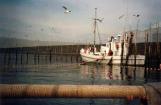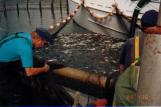1
THE FISHING FLEETThe original fishing fleet was comprised mostly of schooners and smaller rowing vessels. Schooners, powered by sail and later by engines and sails, left port seeking the rich fishing grounds.
Today the Digby wharf is still home to a large fishing fleet, but the vessels have greatly changed. Gone are the days of the dory and the dorymen. Instead we find Scallopers, Draggers, Cape Islanders, Trawlers, and Seiners all equipped with modern technology for navagation, safety and most important, fish finding.
2
1912Nearly 300,000 lbs. of fresh fish were landed at Digby one week in March 1912. Sold at Digby's wholesale fish farms for 2 1/2 cents per pound.
July 28, 1949
Digby Courier
Herring Weirs - Average catch for each tide at a weir runs about 20 hogsheads or 20,000 pounds. This season many larger catches have been made, however, running as high as 60 to 70 hogsheads. For the small or sardine herring present prices are about $20,00 a hogshead with the larger or bait herring bringing $15.00. About 28 cases of sardines are secured from the average hogshead of good sardine herring. A good catch of mixed fish usually nets about 15 cases of processed sardines at a seining.
Dec 2, 1959
Today Scallop catch ranks third in commercial importance among the bivalves harvested
in our Maritime waters, being surpassed by the oyster and rivaling the soft-shell clam.
Nine-tenths of Canada's scallop catch is landed here by the Bay Shore fisherman whose
fleet is the biggest in the world.
1961
744 Fisherman (280 full time - over 10 months) 244 Part Time (5 to 10 months)
220 occasional (less than 5 months)
June 15, 1963
Herring were late in arriving this year
1964
267 Powered Fishing Craft under 10 tons & 73 feet the same over 10 tons DBS Statistics
May 2, 1978
Halifax Chronicle Halifax
Depleted stocks in Bay of Fundy feared. Last year the Digby Scallops catch represented
2% of the total scallop haul, 836,000 pounds out of almost 32 million. Georges Bank
allowable catch is now 540,000 pounds per boat per year.
April 9, 1980
Digby Mirror
It is estimated there are at least 300 licensed calm diggers in Digby County.
June 28, 1983
A weir would cost upward to $50,000.00 to construct a new weir, including the investment
in a boat and gear. The fisherman must apply to the Dept. of Fisheries & Oceans for permission to set up a weir on a designated spot. The season this year was late in coming if at all. As of June 20 the fisherman in a weir off of Rossway had sold 150-200 hogshead or about 1000 barrels of herring so far.
July 10, 1985
Digby Courier
Scallops landed in 1984 by the 65-70 boats which make up the Digby inshore scallop
fleet had a value of $9,280,000.00. The white mussel of the scallop today costs between
$7-$8 a pound. This is a far cry from the 8 to 10 cents a pound scallops were going for in the 1930's. In the 1920's scallops then were very large, six to eight made a pound. In the 1920's they were sold by the gallon. Scallops ranged in price then from $3.25 to $5.00 a gallon in winter. Now they are all sold by the pound. Boats went up to 40-50 feet. Now most scallopers are around 65 feet long and have engines with 300-500 hp. On those earlier boats they used 5hp break gasoline engines. They used to ship scallops in wooden barrels on the trains.
A barrel would hold about 13 US gallons. There was no summer scallop fishing then. The season ended in May and began again in October. At one time they could not sell scallops for 10 cents a pound there were so many of them. The price fell to 8 cents a pound in the 1930's. Fisherman used to get a drag for about $7 or $8. Now it costs around $200.00 for a new one. The bar used to cost $30.00 now around $1,000.00.
Regulations now prohibit fishing inshore from May until October. You have to fish outside
of six miles in the Bay of Fundy. In the 1930's early navigation equipment on the scallop
draggers was a clock and a compass. Now it is all electronics.
Mar 20, 1991
Digby Weekly Courier
History of Scallop Industry Recalled. The late Captain Roland Wornell first discovered
scallops in the Annapolis Basin in 1920 by manual operation of a small drag from a small
boat. From 1936 the scallop fleet grew to about 90 boats in 1945 and during these years
there were a number of buyers in very keen competition. Not long after 1945 there were
fewer boats fishing.
Jan. 24, 1994
The Mail Star
Basin Fisherman say that aquaculture (Salmon) threatens flounder, scallops, lobsters,
clams and rockweed harvest.
Nov 19, 1996
Digby Courier
Lobster licenses fees in Dist 33-34 jumped from $30.00 to $1890.00. The fee was based on gross instead of net income. While landings have risen precipitously since the early 1980's,
so has the fishing effort. There are over 1700 license holders in lobster fishing Areas 33 &
34. In 1995 the lobster landings in the two districts were worth almost $140 million.
Landings for the opening months of the season have steadily increased over the past 3
years in Dist 34. In 1995, landings in Nov & Dec. totaled 5117 metric tonnes, worth almost
$56 million. In 1994 landings during the first 2 months of the season were 4,529 tonnes,
worth over $46 million and in 1993 landings were 3747 tonnes worth $34.8 million.
Nov 19, 1996
Minimum size of lobster - 82mm CL
Licenses: 951 (Category A)
7 (Category B)
12 (Partnership)
Trap Limit: 375/Fall - 400/ Spring (Category A)
113 Fall - 120 Spring (Category B)
563 Fall - 600 Spring (Partnership)
Landings: Landing remained high in LFA34 and the remainder of the Gulf of Maine. Landings in 1993-94 increased by 15% to 10,236 tons, which were the second highest this century and three times the average for the 1950-1979 period. LFA34 accounted for 61 percent of Scotia Fundy and 26 percent of Canadian landings in 1994.
Nova Scotia Live Lobster reports for years:
1993 - $159,074.00
1994 - $197,383.026
1995 - $229,590,866.00
KGM - 13,025,000
KGM - 15,034,122
KGM - 15,625,026
Lobster Fishing Area 34
1984-85 1985-6 1986-7 1987-8 1988-9
5938 6891 7673 8479 8201
1989-90 1990-1 1991-2 1992-3 1993-4
9449 11069 8876 8919 10235*
* Preliminary
Feb 19, 1997
Halifax Chronicle Herald
Catches of Scallops declined to about 1,200 tonnes in 1996 from peak of 4,200 tonnes in
1989 (Bay of Fundy)
June 25, 2003
Digby Courier
St. Mary's Bay weir's dropped from 22 to 7 this year. Herring seiners blamed for the poor
fishery in St. Mary's Bay. More than 150 weirs have disappeared in the last 10 years.
Herring is sold by the hogshead - about 1,240 pounds and for about 9 cents a pound.
4
License reads as follows:License No. 51
Special Fishery License
1st April, 1908 to 31st March, 1909
The hearby named W. W. Hayden, Fred Robinson residents of Digby in consideration of payment, made before the delivery of this License, of the sum of Five dollars, is hereby licensed during the year 1908, to fish one Brush Weir for Herring situated off land owned by Turnbull Ellis Hinxman running off shore 300 feet S.E. & N.E. Wings 300 ft S.W. & N.W. at Bay View, called West Beach, Digby County.
Signed by H. R. Bishop, Fishery Overseer.
Hand written on the top of the License is the following: A. E. Robertson, Inspector
6
This application for a renewal fishery license was applied for by Alexander Adam of Bay View.Description reads as follows:
One Brush Weir for Herring situated off land owned by Turnbull, Adams, Hinxman running off shore 300 feet S.E. by E. Wings 300 ft. S.W. & N.W. at Bay View, called West Beach, Digby Co.
No. of last license 51
Taken out by Fred Robinson & W. W. Hayden who have, giving up or building as they lost money.
Fee: $5.00
8
This picture shows the older style boat, in summer dress, going in to seine the weir.10
Seining the weir(step one):
The seine is tied to the Carrier, and we are going around the weir, in our seine boat, to enclose or capture the herring.
This photo shows one of Connor's Bros. Carriers' is waiting to pump the herring where they will be heavy iced for there trip to Black's Harbour, New Brunswick.
Probably some of the sardines found in grocery stores, with the Connor's Bros.' label came from this weir.
Stanley Stanton's weir in Sandy Cove, Digby County, Nova Scotia. This is the last herring weir on the Nova Scota side of the Bay of Fundy.
12
Seining the Weir:(Step two)
We have brought the ends of the seine together and have pursed (drawn the bottom together) it up and we're beginning to draw the seine in with the roller to dry up the herring.
14
Seining the Weir:(Step three)
Drying up the herring. This is when you draw the herring up closer to the surface so the pump, on the herring carrier, can pump them aboard.





